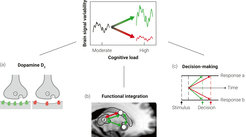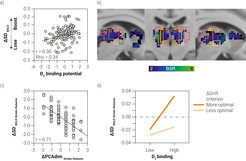Charting the Role of Dopamine in the Aging Human Brain
Center for Lifespan Psychology & Emmy Noether Group: Lifespan Neural Dynamics Group
Author: Douglas D. Garrett
The COBRA study is an international collaboration between three institutions in Sweden and the Institute. It has attained the world’s first longitudinal evidence in humans on the role of dopamine in the aging of brain and behavior.
The Cognition, Brain, and Aging (COBRA) project is a longitudinal study of 181 adults who were between 64 and 68 years of age when they were assessed for the first time in 2012 (Nevalainen et al., 2015). It currently consists of three measurement occasions, each separated by five years. COBRA examines the links among the dopamine (DA) system, other brain parameters (such as grey- and white-matter volumes, white-matter microstructure, cerebral blood flow, and functional activation patterns during rest and task), and cognitive performance. The main focus is on longitudinal changes in “DA capacity” and how they relate to cognitive changes. To measure DA, participants are injected with the ligand raclopride (which binds specifically to DA D2 receptors) while undergoing positron emission tomography (PET) imaging; we then take the resulting estimates of DA binding as a proxy for DA capacity.
COBRA is an international collaboration involving Umeå University, the Karolinska Institutet in Stockholm, the University of Gothenberg, and the MPI for Human Development. All sites have longstanding expertise in the longitudinal study of changes in brain and behavior. Umeå University and Karolinska Institutet contribute specific expertise in dopamine imaging using PET. The MPI for Human Development contributes specific expertise in the analysis of brain dynamics (Lifespan Neural Dynamics Group) and multivariate modeling (Formal Methods project of the Center for Lifespan Psychology). Combined, the scientists of the four sites provide the synergy required to conduct a multi-modal, longitudinal study of this scope.
The main objective of COBRA is to delineate the average pattern of DA system changes in normal aging as well as the range of between-person differences in this pattern. Given the central role of DA in cognitive, motor, and motivational aspects of behavior, gaining knowledge about DA changes in normal cognitive aging, and about the magnitude of individual differences therein, is of fundamental importance for research on human cognitive aging. We hypothesize that DA decline is exacerbated in some individuals, and that these individuals will be characterized by pronounced cognitive decline.

Specifically, COBRA seeks to shed light on four central questions of cognitive aging research:
- The average degree, regional distribution, and between-person differences of age-related changes in DA capacity.
- The shared and unique contributions of changes in DA capacity, grey matter, and white matter to cognitive change in old age.
- The lead—lag relations between different neural and vascular correlates of cognitive decline. To assess such relations, which may differ between individuals, more than two longitudinal measurement occasions are imperative.
- The modulatory and possibly ameliorative effects of lifestyle factors, assessed by cognitive, physical, and social activity patterns, on changes in brain and behavior.
The first wave of data collection in COBRA began in 2012 and involved 181 healthy adults between 64 and 68 years of age. The second wave started 5 years later, when 129 of the original participants returned for repeated testing. Recently, a third wave has been added (see Figure 1). Current work focuses on data of the 10-year follow-up as well as analyses and documentation covering all three measurement occasions, allowing for unprecedented investigations of lead—lag relations of the aging brain and their links to individual differences in cognitive change.

Figure 1. Timeline and testing procedure of the COBRA project. MMSE = Mini-Mental State Exemination; WAIS = Wechsler Adult Intelligence Scale; MRI = magnetic resonance imaging; PET = positron emission tomography.
Adapted from Nevalainen et al. (2015)
Original image licensed under CC BY-NC-ND 3.0

Figure 2. Dopamine pathways. In the brain, dopamine plays an important role in the regulation of reward and motor activity. As part of the reward pathway, dopamine is synthesized in nerve cell bodies located within the ventral tegmental area (VTA) and is released in the nucleus accumbens and in prefrontal cortex. Its motor functions are linked to a separate pathway, with cell bodies in the substantia nigra that produce and release dopamine into the striatum.
Dopamine Capacity, Neural Variability Regulation, and Cognitive Performance in Old Age
We now turn to an on-going, broad-scale COBRA effort led by the Berlin side (Garrett et al., 2023). In this data analysis project, we examine individual differences in the ability to regulate moment-to-moment neural variability in response to changes in cognitive demands. In the context of working memory, we consider three “lenses” through which neural variability regulation can be understood: (a) DA capacity, which is known to push neural variability in different directions (see Garrett et al., 2015); (b) network-level functional integration, implying that brain regions expressing greater variability may also “work together” more efficiently; (c) adaptation in decision-making processes to changing task demands (see Figure 3). We find that, under greater working memory load, increased neural variability is indeed associated with elevated DA capacity and heightened functional integration, and that these effects are dominantly expressed in the striato-thalamic system rather than in cortex. Behavioral modeling reveals that working memory load evoked substantial decision biases during evidence accumulation, and that those individuals who jointly expressed a more optimal decision bias and had higher dopamine capacity were also more likely to express increased striato-thalamic variability under load (Figure 4). These findings are consistent with the hypothesis that the ability to tune striato-thalamic variability to the level of cognitive demand may be a hallmark of a well-maintained older adult brain that allows for high levels of cognitive performance (Nyberg et al., 2022).

Figure 3. Probing individual differences in neural variability modulation with increasing cognitive load from three complementary perspectives. Older adults who express increased neural variability under greater load (green) are expected to exhibit (a) greater dopamine capacity, (b) higher functional integration between brain regions (here, between thalamus (node (a) and striatum), and (c) more effective decision-making.
Adapted from Garrett et al. (2023)
Original image licensed under CC BY-NC-ND 4.0

Figure 4. Moment-to-moment brain signal variability (SDBOLD) in the striato-thalamic system under working memory load and its association with dopamine (DA) capacity. (a) Those who increase SDBOLD under load also have higher DA capacity. (b) Overlay of the Morel nucleic atlas showing key results for the intralaminar, mediodorsal, and “motor” (ventro-medial, -lateral, and -anterior) thalamic nuclei. BSR = bootstrap ratio (higher values = more robust effects). (c) Bivariate correlation between working memory load-related changes in functional network integration (ΔPCAdim) and ΔSDBOLD in the striato-thalamic system; those who increase functional integration also elevate SDBOLD under load. (d) Participants expressing greater increases in SDBOLD under load also have higher DA capacity and better maintain an optimal decision criterion under load.
Adapted from Garrett et al. (2023)
Original image licensed under CC BY-NC-ND 4.0
This complex data analysis project was based on first-occasion data from COBRA. In follow-up work, we will investigate links of longitudinal changes in DA capacity, functional integration, and decision-making processes to changes in neural variability regulation, using all three measurement occasions currently available in COBRA.
Research Project in Brief
Topic:The Cognition, Brain, and Aging (COBRA) project
Principal Investigators: Lars Bäckman (Professor, Aging Research Center, Karolinska Institutet, Sweden), Ulman Lindenberger (Director, Center for Lifespan Psychology, MPI for Human Development, Berlin, Germany), Martin Lövdén (Professor, University of Gothenberg, Sweden), Lars Nyberg (Professor, Center for Functional Brain Imaging, Umeå University, Sweden), and Katrine Ricklund (Pro-Vice-Chancellor, Umeå University, Sweden).
Researchers at Berlin site: Douglas D. Garrett (Head, Lifespan Neural Dynamics Group, MPI for Human Development, Berlin, Germany), Ulman Lindenberger (Director, Center for Lifespan Psychology, MPI for Human Development, Berlin, Germany)
Period: 2012–ongoing
Funding: e.g., Swedish Research Council, FORTE, Umeå University, the Umeå University–Karolinska Institutet Strategic Neuroscience program, Knut and Alice Wallenberg Foundation, Torsten Söderberg Foundation, Ragnar Söderberg Foundation, a donation of the Jochnick Foundation, Swedish Brain Power, Swedish Brain Foundation, Västerbotten County Council, Strategic Innovation Fund/Max Planck Society, the Gottfried Wilhelm Leibniz Prize 2010 of the German Research Foundation (DFG), and the Swedish National Infrastructure for Computing (SNIC) through the Abisko computer cluster at Umeå University.
Selected COBRA Publications:




